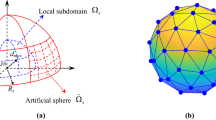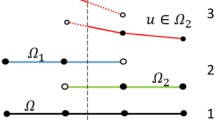Abstract
In this paper we propose a new mesh-less method based on a sub-domain collocation approach. By reducing the size of the sub-domains the method becomes similar to the well-known finite point method (FPM) and thus it can be regarded as the generalized form of finite point method (GFPM). However, unlike the FPM, the equilibrium equations are weakly satisfied on the sub-domains. It is shown that the accuracy of the results is dependent on the sizes of the sub-domains. To find an optimal size for a sub-domain we propose a patch test procedure in which a set of polynomials of higher order than those chosen for the approximations/interpolations are used as the exact solution and a suitable error norm is minimized through a size tuning procedure. In this paper we have employed the GFPM in elasto-static problems. We give the results of the size optimization in a series of tables for further use. Also the results of the integrations on a generic sub-domain are given as a series of library functions for those who want to use GFPM as a cheap and fast integral-based mesh-less method. The performance of GFPM has been demonstrated by solving several sample problems.
Similar content being viewed by others
References
Duarte CA (1995) A Review of some meshless methods to solve partial differential equations. TICAM Report 95-06, Texas Institute for Computational and Applied Mathematics
Li S, Liu WK (2002) Meshfree particle methods and their applications. Appl Mech Rev 54: 1–34
Nguyen VP, Rabczuk T, Bordas S, Duflot M (2008) Meshless methods: a review and computer implementation aspects. Math Comput Simul (in press)
Boroomand B, Tabatabaei AA, Oñate E (2005) Simple modifications for stabilization of the finite point method. Int J Numer Methods Eng 63: 351–379
Perrone N, Kao R (1975) A general finite difference method for arbitrary meshes. Comput Struct 5: 45–58
Nayroles GB, Villon P, Villon P (1992) Generalizing the finite element method: diffuse approximation and diffuse elements. Comput Mech 10: 307–318
Belytschko T, Lu YY, Gu L (1994) Element-free Galerkin methods. Int J Numer Methods Eng 37: 229–256
Liu WK, Jun S, Li S, Adee J, Belytschko T (1995) Reproducing kernel particle methods for structural dynamics. Int J Numer Methods Eng 38: 1655–1679
Fasshauer GE (1997) Solving partial differential equations by collocation with radial basis functions. In: Mehaute AL, Rabut C, Schumaker LL (eds) Surface fitting and multiresolution methods, pp 131–138
Oñate E, Idelsohn S, Zienkiewicz OC, Taylor RL (1996) A finite point method in computational mechanics—applications to convective transport and fluid flow. Int J Numer Methods Eng 139: 3839–3866
Atluri SN, Zhu T (2000) The meshless local Petrov–Galerkin (MLPG) approach for solving problems in elasto-statics. Comput Mech 25: 169–179
Aluru NR (2000) A point collocation method based on reproducing kernel approximations. Int J Numer Methods Eng 47: 1083– 1121
Huerta A, Vidal Y, Villon P (2004) Pseudo-divergence-free element free Galerkin method for incompressible fluid flow. Comput Methods Appl Mech Eng 193: 1119–1136
Krongauz Y, Belytschko T (1998) EFG approximation with discontinuous derivatives. Int J Numer Methods Eng 41: 1215–1233
Carpinteri A, Ferro G, Ventura G (2002) The partition of unity quadrature in meshless methods. Int J Numer Methods Eng 54: 987–1006
Duarte CA, Oden JT (1996) HP clouds—an HP meshless method. Int J Numer Methods Eng 12: 673–705
Kucherov L, Tadmor EB, Miller RE (2000) Umbrella spherical integration: a stable meshless method for nonlinear solids. Int J Numer Methods Eng 69: 2807–2847
Oñate E, Idelsohn S (1998) A mesh-free finite point method for advective-diffusive transport and fluid flow problems. Comput Mech 21(4/5): 283–292
Oñate E, Sacco C, Idelsohn S (2000) A finite point method for incompressible flow problems. Comput Vis Sci 2: 67–75
Löhner R, Sacco C, Oñate E (2002) A finite point method for compressible flow. Int J Numer Methods Eng 53: 1765–1779
Kim DW, Kim Y-S (2003) Point collocation methods using the fast moving least square reproducing kernel approximation. Int J Numer Methods Eng 56: 1445–1464
Lee S-H, Yoon Y-C (2004) Meshfree point collocation method for elasticity and crack problem. Int J Numer Methods Eng 61(1): 22–48
Sadeghirad A, Mohammadi S (2007) Equilibrium on line method (ELM) for imposition of Neumann boundary conditions in the finite point method (FPM). Int J Numer Methods Eng 69: 60–86
Ortega E, Oñate E, Idelsohn S (2007) An improved finite point method for tridimensional potential flows. Comput Mech 40: 949–963
Boroomand B, Mossaiby F (2005) Generalization of robustness test procedure for error estimators. Part I: formulation for patches near kinked boundaries. Int J Numer Methods Eng 64: 427–460
Boroomand B, Mossaiby F (2005) Generalization of robustness test procedure for error estimators. Part II: test results for error estimators using SPR and REP. Int J Numer Methods Eng 64: 461–502
Timoshenko SP, Goodier JN (1970) Theory of elasticity, 3rd edn. McGraw-Hill, New York
Babuška I, Strouboulis T, GangarajSK. Upadhyay CS (1997) Pollution error in the h-version of the finite element method and the local quality of the recovered derivatives. Comput Methods Appl Mech Eng 140: 1–39
Author information
Authors and Affiliations
Corresponding author
Rights and permissions
About this article
Cite this article
Boroomand, B., Najjar, M. & Oñate, E. The generalized finite point method. Comput Mech 44, 173–190 (2009). https://doi.org/10.1007/s00466-009-0363-x
Received:
Accepted:
Published:
Issue Date:
DOI: https://doi.org/10.1007/s00466-009-0363-x




